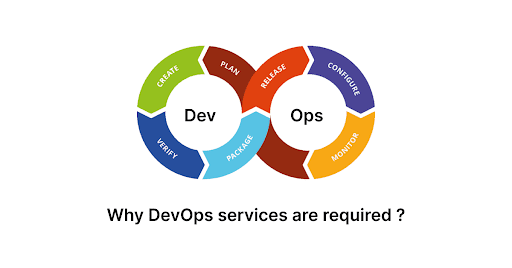
Blog
Why DevOps Services Required?Posted by
Kanika Sharma on 03 Aug 2023
In the rapidly changing world of modern software development, it’s more important than ever that development and operations work together. It has given rise to the new “DevOps” method, which turns traditional “siloed” practices into a collaborative, streamlined process.
DevOps services are at the heart of this transformation, which are important tools and practices that help development and operations teams interact, deploy software quickly, and keep working together. In this blog, we explain why DevOps services are helpful and necessary for any company that wants to improve its software release life cycle in speed, efficiency, and quality.
What is DevOps?
DevOps is a set of practices, concepts, and cultural beliefs that aim to improve how software development (Dev) and IT operations (Ops) teams work together and communicate. Also, DevOps targets to make software development faster, more reliable, and of better quality. It is done by making the software development life cycle more efficient and streamlined.
By combining automation, continuous integration, and continuous delivery (CI/CD) pipelines, this new way of thinking improves the software lifecycle. Basically, DevOps creates a mindset of shared responsibility for the whole lifecycle of an application by using quick feedback loops and incremental improvements. Also, DevOps speeds up the creation of a DevOps service by bringing together development and operations to create a symphony of automation. It makes it possible to release software frequently, securely, and reliably while meeting business goals.
Why DevOps Services Required – Some Reasons
DevOps uses both technical and cultural changes to make software release faster, quality, and more efficiently. Here are some of the most important reasons to use DevOps services:
Faster Software Delivery
DevOps makes continuous integration and continuous delivery (CI/CD) easier, making it possible to deliver software quickly and automatically. As well as, teams can often update the software by automating the build, test, and launch processes. It cuts the time it takes to release software from weeks or months to days or even hours. It lets companies act quickly to market needs and user feedback.
Better Quality Software
Testing and quality assurance that are done automatically are essential parts of DevOps techniques. By testing early on in the building process, problems can be found and fixed quickly. It leads to fewer software bugs, better security, and a better experience for end users. Continuous monitoring and feedback loops keep the software quality good over its entire lifecycle.
Increased Efficiency and Productivity
DevOps helps the development and operations teams collaborate on projects and share responsibilities. Automation streamlines manual tasks, such as provisioning and configuration management, freeing up valuable time for teams to focus on innovation. This collaborative environment makes it easier for people to make decisions quickly, which cuts down on bottlenecks and improves total efficiency.
Cost Savings
DevOps is based on technology, which cuts down on manual work and human errors. It saves money over time. With shorter development cycles, faster bug detection, and better use of assets, companies can better allocate their resources. Also, fixing bugs costs less when problems are dealt with early in creation.
Better Scalability and Flexibility
Infrastructure as code and cloud-native approaches are essential to DevOps concepts. It lets groups adjust their resources up or down based on demand, making them more scalable and flexible. With automated provisioning and configuration management, it’s easier to make consistent copies of environments, which makes the deployment process more reliable and repeatable.
Security
DevOps integrates security practices throughout the development lifecycle. Implementing security measures early can identify and remediate vulnerabilities before they become major concerns. Automated security scans, code analysis, and compliance checks ensure that security remains a top priority without slowing development.
Less Manual Intervention
Automation lies at the heart of DevOps Services. Manual tasks, which are prone to errors and delays, are minimized through automation scripts and tools. Infrastructure provisioning, configuration management, testing, and deployment are automated, reducing the need for manual intervention. It not only speeds up processes but also increases consistency and reliability.
Common Challenges of DevOps
DevOps, a set of practices combining software development (Dev) and IT operations (Ops) to shorten the systems development life cycle and deliver high-quality software faster, is challenging. While it promises increased efficiency, collaboration, and agility, organizations often face several technical challenges during DevOps implementation.
Environmental Challenges in DevOps
Managing multiple environments (development, testing, staging, production) can be complex in a DevOps environment. As well as, keeping these environments consistent and ensuring that changes are accurately replicated can lead to configuration drift and compatibility issues. Automated provisioning tools and infrastructure-as-code practices can mitigate this by enabling consistent and repeatable environment setups.
Dealing with Obsolete Practices
Basically, legacy processes and outdated practices can hinder the success of DevOps initiatives. Overcoming resistance to change and convincing teams to adopt new methodologies can take time and effort.
Monitoring the DevOps Process
Monitoring the entire DevOps pipeline, from code commits to production deployment, is crucial for early issue detection and resolution. Implementing a comprehensive monitoring and alerting system can be complex. Still, it’s essential to track metrics like build times, deployment frequency, error rates, and response times to ensure the process meets its objectives.
CI/CD Performance Issues
Continuous Integration (CI) and Continuous Deployment (CD) are core DevOps practices, but ensuring that the CI/CD pipelines are fast and reliable can be challenging. Slow build and deployment times can delay getting new features to users. Optimizing the pipeline through parallelization, caching, and efficient testing strategies can address these performance issues.
Version Control in Test Automation
Version control is crucial for tracking changes in source code, but it’s equally essential for test automation artifacts. Managing versions of test scripts, data sets, and configurations can become complex. Also, adopting version control systems for test assets ensures consistency, reproducibility, and collaboration among testing teams.
Interpretation of Complex Debugging Reports
In a DevOps environment, debugging reports from different pipeline stages can be overwhelming. To find the root cause of a problem, you need to be able to look at logs, stack traces, and performance data. Basically, debugging and fixing problems can be easier using unified logging, structured logging practices, and AIOps (Artificial Intelligence for IT Operations) tools. As well as, Infrastructure monitoring in DevOps, such as for Amazon RDS, ensures continuous visibility into database performance, availability, and resource utilization, enabling proactive management and optimization.
Conclusion
A need of DevOps services has become more precise as technology changes quickly. As well as, The discussion has shown that DevOps services are vital for many reasons, such as the need to release software more quickly and for development and operations teams to work well together.
By promoting a continuous integration, deployment, and delivery culture, DevOps not only speeds up development processes and makes them more efficient, but it also improves product quality and customer satisfaction.
About Gophers Lab
Gophers Lab DevOps Services offers a single solution for improving software development. As well as, leveraging containerization and orchestration technologies like Docker and Kubernetes, we can automate the provisioning, scaling, and monitoring of apps, making sure they work the same way in different environments. Also, pipelines for continuous integration and continuous deployment (CI/CD) on the place make it easy to add new code quickly, test it automatically, and have trusted release ways.
Checkout Our Different Services
Share On
Tags
devops automation services
devops services
Highlights
Download Blog

Talk to Our Experts

Get in Touch with us for a Walkthrough





